Combating terrorism with crash tested road blockers
 More than ever before, many of the world’s institutions and organisations face a serious threat of terrorist attack. Over recent years the terrorist threat in the UK has constantly been set between ‘moderate’ and ‘severe’ which means that an attack is highly likely.
More than ever before, many of the world’s institutions and organisations face a serious threat of terrorist attack. Over recent years the terrorist threat in the UK has constantly been set between ‘moderate’ and ‘severe’ which means that an attack is highly likely.
Due to this serious terror threat, many financial, government and private organisations are seeking ways to reduce the threat, and subsequent damage that can happen as a result of terrorism.
Anti-terrorism crash road tested road blockers are an effective tool in preventing vehicles from gaining access to important, restricted areas and also act as a deterrent to anyone planning an attack.
Gateway’s own GA100000 Shallow-Mounted Road Blocker was crash tested at MIRA (Motor Industry Research Association) with great success, passing 100% with “0” penetration and still remaining operable after impact.
Whereas once it was government institutions that were most at risk from terrorist attacks, in today’s climate private sector companies are just as vulnerable. This is why crash tested road blockers are regularly employed in a variety of environments such as banks, depots, ports, airports and utility providers, as well as armed forces sites and government buildings.
If you have identified your site as needing a high level of security to counter a terrorist threat then you should consider installing a road blocker. Crash tested road blockers work best as a part of a full security system which could also include bollards, barriers, gates and other access control equipment.
Gateway Automation provides free, no obligation quotes and feasibility surveys for your premises. To assess your security requirements, please contact us here.
Related articles:
How to combat crime by securing your reception area
![clip_image002[5] clip_image002[5]](https://gatewayautomation.co.uk/wp-content/uploads/2021/06/clip_image00225255B525255D_thumb25255B125255D.jpg) While reception areas can be a pleasant and welcoming place for greeting new clients and customers, they also have a vital role to play in providing protection against criminal activities.
While reception areas can be a pleasant and welcoming place for greeting new clients and customers, they also have a vital role to play in providing protection against criminal activities.
Aside from the typical duties of greeting visitors, answering calls and handling incoming mail, today’s receptionists should have a good grasp on security threats. This means being aware, using guest books and visitor badges and staying up to date on the latest scams.
However, no matter how well prepared your receptionist, there is always the potential for human error and businesses should be aware of technology which can further aid them in their security efforts.
Proximity devices
One highly successful way to prevent access to specific areas of your business is to utilise proximity devices. Keypads can be used to restrict access, with the entry code shared only with those members of staff who need it. Similarly proximity cards can be used and this reduces the need for staff to remember a specific entry code. Many proximity cards such as our PC-200 proximity cards feature ‘smart chips’ which mean that users simply have to press their card against a reader rather than having to insert it.
Biometric fingerprint readers
Fingerprint recognition devices are a secure and reliable way to control access to unauthorised areas. The human fingerprint is unique to each and every person making it a very effective way of securing a building or an area. Using fingerprint recognition reduces the need to remember a code or present a card which significantly reduces risk.
Waist & Half Height Turnstiles 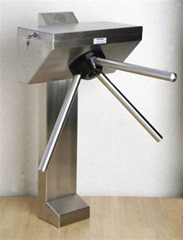 Tail gating is a common tactic that criminals use to gain unauthorised access to a building. This happens when a criminal quickly follows behind another person shielding them from view as they gain access.
Tail gating is a common tactic that criminals use to gain unauthorised access to a building. This happens when a criminal quickly follows behind another person shielding them from view as they gain access.
Training staff to watch out for the tell tale signs of tailgating but installing a waist or half height turnstile is a much more fool-proof method.
A turnstile can help to manage traffic in a number of ways. It can slow down traffic by restricting flow to once person at a time and halt access until the person shows identification or until they provide payment.
Examples of settings where half height turnstiles are popular include offices, libraries and leisure facilities.
For more information about our range of access control equipment to help secure reception areas, please visit our website here or arrange a call back with one of our members of staff here.
Manual swing gates: Facts, uses and installation
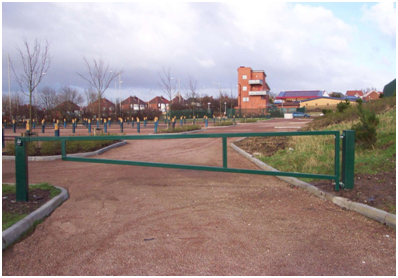 Although a great number of advancements have been made in recent years in the design and production of automatic gate systems, their predecessors, manual swing gates, still prove to be a low cost and very practical option for lots of businesses.
Although a great number of advancements have been made in recent years in the design and production of automatic gate systems, their predecessors, manual swing gates, still prove to be a low cost and very practical option for lots of businesses.
Manual swing gates are ideal for positioning in situations or locations where it does not make the extra investment of automatic gate systems necessary or cost effective.
Typically, the flexibility offered by manual swing gates has seen them installed in a wide variety of different locations including car parks, business driveways and more general traffic management requirements.
Swing gates provide an arm that acts to block off access to areas which you wish to close off. When access is required, the arm can be swung open manually at a 90 degree angle and closed again afterwards. This arm is hollow, making it much easier for the operator to open and close to the gate if and when access is required.
This gate can be locked in an open or closed position with the use of a padlock, enabling you to provide excellent security and peace of mind during overnight or holiday periods when access is likely not to be required, but also providing you with the flexibility to lock in the open position should you expect high volumes of authorised traffic.
An additional latch post is required to lock this gate in the open position, but it is strongly encouraged to stop the gate swinging back into pedestrians or vehicles during times when you want to gate to be kept open.
For more information on our range of manual swing gates, including specifications and installation, please visit our website here or arrange a call back with one of our members of staff here.
What to do if you become a victim of business crime
 Whether you’re a small market trader or a large multinational company, there’s a good chance that at some point you may become a victim of business crime. In 2014 alone there were 13,070 cases of business crime reported in the wholesale and retail sectors, with 41% of businesses reporting that they had been a victim of some kind of crime. Therefore, with the risk of becoming a victim of business crime ever present, it’s important that you’re well equipped to deal with this scenario and know what to do following an act of crime against your business.
Whether you’re a small market trader or a large multinational company, there’s a good chance that at some point you may become a victim of business crime. In 2014 alone there were 13,070 cases of business crime reported in the wholesale and retail sectors, with 41% of businesses reporting that they had been a victim of some kind of crime. Therefore, with the risk of becoming a victim of business crime ever present, it’s important that you’re well equipped to deal with this scenario and know what to do following an act of crime against your business.
Step 1 – Don’t touch anything
Although you might be tempted to assess the damage yourself, for example by opening safes and checking for entrance points, this can be counterproductive and often greatly reduce the chances of catching the perpetrator. Although some criminals will wear gloves, not all of them do and valuable evidence such as strands of hair, fingerprints and skin cells can be left behind, all of which can be used to catch the person who committed the crime and make a case against them. It is therefore vital that you let the police investigators do their job. If you find anything that you think might have been left behind by the criminal(s), you shouldn’t pick it up. Instead, bring it to the attention of investigators.
Step 2 – File a police report
Although it might not seem like a top priority at the time, it’s advisable to file a police report as soon as possible, within 24 hours if you can. This way your memory will still be fresh from the incident and will likely make the process of claiming through your insurance company much easier. Be sure to collect a detailed list of everything that’s missing or broken and take pictures of the affected areas for further evidence.
Step 3 – Restore your business
It is important to try and restore normality within your business as soon as possible. It can be an emotional time, but know that the attack was probably not anything personal and most likely motivated by financial gain. Getting the business back up and running as quickly as possible will not only reduce further loss of income, but will give your customers and suppliers confidence in you and may also help your staff start to feel more comfortable and relaxed as day to day life within the workplace is restored.
Step 4 – Take action
Take a look at your business from an outside perspective and ask yourself some tough questions. How was it that your business became a victim? How did the criminals get into the premises? What are the areas in which your security is lacking? And perhaps most crucially, what do you need to implement to ensure this does not happen again?
Criminals that have been successful in targeting a particular business in the past are more likely to go back to commit similar crimes. Failing to take action after break-ins and robberies is a sure fire way to increase your chances of repeat crime. At Gateway we offer a wide range of different security features designed to stop business crime. These include:
- Barriers
- Gates
- Turnstiles
- Access control equipment
- Flow control plates
- Security posts
- Speed ramps
- Automatic rising kerbs
- Crash tested road blockers
- Bollards
Whether your business runs from small retail premises or a large industrial site, we can provide you with a free, no-obligation quotation and feasibility survey to assess your perimeter security requirements. For more information on any of the security options above, or for further advice on how to protect your business premises from criminals, please contact us here.
Why might cantilever sliding gates be right for your business?
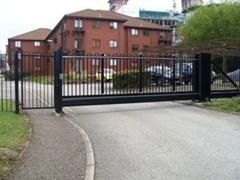 In recent years, there has been an increase in the use of cantilever sliding gates as a method of securing property perimeters. This article looks at what they are and why they are so popular.
In recent years, there has been an increase in the use of cantilever sliding gates as a method of securing property perimeters. This article looks at what they are and why they are so popular.
Cantilever sliding gates open and close by retracting horizontally. The gate is suspended over the entrance points with horizontal posts and slides back into place with the use of motors and rollers, thus eliminating the need to run a track along the length of the opening.
Rollers allow for the gate to be suspended above the ground which makes for a much smoother operation. This is because without the need for a track along the opening much less friction is incurred whilst the gate performs its cycle. As a result, the gate is much quieter and endures less operational wear and tear in the process. This in turn reduces how regularly maintenance is needed on the gate system, saving both time and money.
The horizontal retraction of this gate system means that it can be a good option for businesses that are restricted by space in their car park or driveway. As no room is needed for the gate to open outwards like with other gate systems, this can give businesses extra space within their property which can be put to better use.
Cantilever sliding gates are even able to be fitted on driveways and entrances where there is uneven ground because there is no need for a ground track fitting along the entrance. This eliminates the need for ground levelling which can greatly increase the cost of installation for gate systems which require even ground.
To summarise the main features of cantilever sliding gates:
- Smooth operation
- Low maintenance
- No ground track required
- Quiet during operation
- Can operate on uneven ground
- More space offered because they do not require space to open outwards
For more information on fitting and installing cantilever sliding gates on your premises, please visit our website here.
How attractive is your business property to criminals?
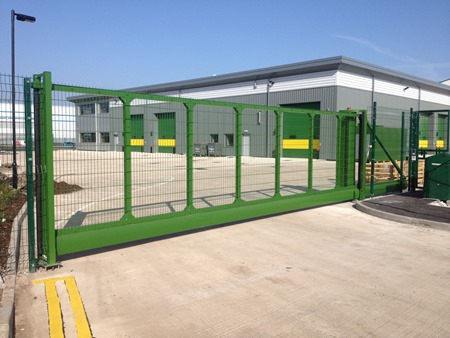 There is a good chance that you might have heard estate agents use a term called ‘kerb appeal’. This is a measure they use to determine how attractive your home looks from the outside.
There is a good chance that you might have heard estate agents use a term called ‘kerb appeal’. This is a measure they use to determine how attractive your home looks from the outside.
Well, the same term can be applied with regards to business crime and how attractive your business looks to criminals from the outside. It is likely that criminals targeting businesses will, in the same way, view properties with low levels of security as a more attractive prospect.
Failing to have the necessary security protection in place makes it much easier for criminals to be successful in their attempts, which in turn makes you a more attractive property to target for opportunistic or planned crime. To deter the threat of business crime, you need to make sure that your property is unappealing to criminals. In other words, make sure that your property is so well secured that the potential difficultly of gaining access and risk of getting caught outweighs any potential benefits of committing the crime.
The following are a few different tactics that will bring down your ‘kerb appeal’, and reduce the chances of you becoming a victim of business crime.
Access control equipment
Those businesses not operating with access control equipment such as intercoms and proximity devices can quickly find themselves easy targets. Opportunistic criminals look to take advantage of businesses that cannot control access to their premises, even striking during working hours while employees are busy with work. Installing access control equipment ensures that doors will only be opened to those who have approved access whilst keeping out unwanted intruders.
Gates and barriers
Installing barriers and gates will block off unapproved vehicle access and greatly reduce the threat of your business falling victim to a ‘smash and grab’ style raid. Without vehicle access, intruders are also going to be limited as to what they can carry away from your premises. Furthermore, a lack of easy access to a getaway vehicle greatly increases the risk of getting caught and in many cases criminals will choose against even attempting to gain access to your property because it will be far too difficult for them to do so.
As business crime tactics constantly evolve so too must our range of security equipment. At Gateway we offer a large range of options designed to stop the threat of business crime which includes:
- Barriers
- Gates
- Turnstiles
- Access control equipment
- Flow control plates
- Security posts
- Speed ramps
- Automatic rising kerbs
- Crash tested road blockers
- Bollards
For more information on any one of these, please contact us here.
How proximity cards can be used to keep educational facilities safe and secure
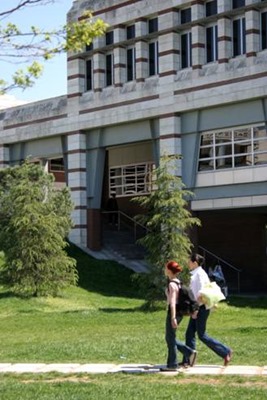 Colleges and universities present unique security challenges, and it can feel like trying to protect a small city at times with lots of different departments, each requiring different levels of security. Combine this with the need to keep unauthorised individuals out, whilst at the same time letting in upwards of 30,000 people to the universities facilities, and you can quickly find yourself in a logistical nightmare.
Colleges and universities present unique security challenges, and it can feel like trying to protect a small city at times with lots of different departments, each requiring different levels of security. Combine this with the need to keep unauthorised individuals out, whilst at the same time letting in upwards of 30,000 people to the universities facilities, and you can quickly find yourself in a logistical nightmare.
Clearly, it’s not possible to manually check each individual entrant, as this would not only be time consuming but also extremely costly. At the same time you can’t just give anyone access to facilities filled with expensive equipment and sensitive information. This is a key reason why more and more universities are starting to take advantage of the opportunities offered through proximity cards to keep educational environments safe and secure.
Proximity smart cards are used in the same respect as contact smart cards. Information from the card is systematically compared against a controlled list in order to identify whether or not access should be granted. The cards offer the added convenience and speed of simply swiping the card as you walk through rather than having to insert the card into a reader. Applications for this type of access control have been growing; electronic passports, vending, parking tolls and increasingly student identification are all common applications for proximity cards.
Installing proximity cards will not only take pressure off the logistical side of running colleges and universities, but also prove to be a great source of student satisfaction, providing a heightened feeling of safety whilst also offering a much higher level of convenience for students wanting to access the facilities than more traditional methods of security. In the case of proximity cards, access security has no invasive or threatening aspects, and it can even be aesthetically pleasing. What could be simpler than walking up to a door and walking in, just as if it was unlocked?
The big advantage of proximity cards lies in its simplicity. There are no moving parts, no user wear and no slots to maintain. The reader can be concealed inside walls or special enclosures or mounted alongside turnstiles. Proximity cards are much less prone to physical damage or loss, saving you money in reduced card replacement cost, and again, much more convenience for the end user.
At Gateway Automation Ltd, we have looked at how to further strengthen our range of high quality, low cost security access solutions, and proximity cards are just one of the ways in which access can be controlled. For more information about our different access control solutions, please visit http://www.gatewayautomation.co.uk/access-control-equipment/
Related articles
Why automated bollards might be the right choice for you
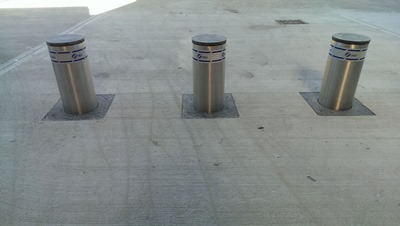 Did you know that bollards have been used as a method of managing traffic flows for almost 300 years? Designed to guide traffic and protect sensitive areas, bollards have come a long way since first being introduced, when many were constructed from disused cannon barrels buried into the ground. Although these rudimentary prototypes helped to inspire the design of modern bollards that are frequently seen in many of the UK’s towns and cities today, modern day bollards are completely different, having evolved into the highly functional, reliable, automated systems that Gateway now use. But what makes automated bollards the right choice for you?
Did you know that bollards have been used as a method of managing traffic flows for almost 300 years? Designed to guide traffic and protect sensitive areas, bollards have come a long way since first being introduced, when many were constructed from disused cannon barrels buried into the ground. Although these rudimentary prototypes helped to inspire the design of modern bollards that are frequently seen in many of the UK’s towns and cities today, modern day bollards are completely different, having evolved into the highly functional, reliable, automated systems that Gateway now use. But what makes automated bollards the right choice for you?
Flexibility
Sometimes there comes a need to be able to quickly open up areas of access that have previously been blocked off by bollards. The flexibility offered by an automated bollard system means that they are able to fit seamlessly into any new or existing pedestrian areas, allowing them to block off unauthorised traffic whilst staying flexible to the needs of those that require access to the area. Often, these types of bollards prove useful when enforcing traffic rules that are time related. This flexibility can be seen in action throughout the UK with automated bollard systems fast becoming the preferred method of traffic control in city centres.
Aesthetics
Typically, for those businesses that are exposed to the public eye, there is a need to maintain good aesthetics, whilst also ensuring both security and preventing unauthorised access. With a sleek stainless steel design contributing to the visual quality of both the building and landscape, coupled with the functionality of more traditional bollard systems, automated systems could be a good choice for businesses looking to control vehicle access whilst keeping up good appearances.
Performance
Automated systems bring about excellent performance benefits to those employing this type of access security. Automated bollards take just 6 seconds to complete their cycle from blocking off access to allowing entrants, and provide the necessary protection and security whilst ensuring that the day to day running of the business is not held up waiting for these bollards to allow entry to the premises. The added convenience offered through an automated system saves both time and money as it can be fully integrated with access control equipment, traffic lights and ground loops, which opens up the options of unmanned access points. In addition, in the event of an emergency or power failure they can be lowered manually.
Automated bollards are just one of the security systems we offer, but we understand that every need is different. Hopefully this has helped to inform you of what automated bollards might offer to you, but for more information visit http://www.gatewayautomation.co.uk/bollards/automatic/ga7276h-automatic-bollard/
Pay and display systems
 In the UK, pay and display systems are used in a variety of parking areas including on-street parking, car parks and multi-story car parks. A pay and display system is most commonly used for monetising a vehicle parking area. They are simple to operate as they rely on the customer purchasing a ticket and displaying that ticket on their dashboard or windscreen. The details on a parking ticket will usually include the date, time of purchase, expiry time, cost of the ticket, location and the machine operator.
In the UK, pay and display systems are used in a variety of parking areas including on-street parking, car parks and multi-story car parks. A pay and display system is most commonly used for monetising a vehicle parking area. They are simple to operate as they rely on the customer purchasing a ticket and displaying that ticket on their dashboard or windscreen. The details on a parking ticket will usually include the date, time of purchase, expiry time, cost of the ticket, location and the machine operator.
To ensure people follow this system an on-site parking attendant is required to check tickets are valid and on display. This attendant is also responsible for issuing parking notice charges should they find a vehicle without a valid parking ticket.
Compared to parking metres the main advantage of pay and display machines is that one machine can serve multiple vehicle spaces at a time. At Gateway Automation we offer custom manufactured parking systems to meet your requirements.
The Elite LS pay & display machine is made from 2.5mm steel with a reinforced armour plated vault and a 9mm reinforced vault door with no external lock. The vault is secured with an electronic locking and key locking system which is manufactured by KABA who are one of the leading providers of innovative access solutions within the security industry. This is an important feature as the Elite LS houses a 6 litre cash box. The machine can hold 4000 tickets on one roll and can accept either the Euro or the Pound depending on your location. It can be powered by solar or mains electricity, features a 5” monochrome display, you can choose the colour of your machine and it is also illuminated to make it visible in low light.
Additionally, our optional extras allow you to customise your machine to meet your individual needs. These options include:
- chip & pin payment system
- bank note acceptance
- alpha-numeric keypad
- GPRS (Web ASLAN) for real time monitoring
- additional 2nd printer that increases ticket capacity to 8000
- spare cash box
- hardlite™ vault protection
- hybrid power system which uses a combination of mains and solar power
- anti-graffiti coating
Gateway Automation can provide free, no obligation quotes and feasibility surveys for your premises. To get us to assess your security requirements, please contact us here.
Related articles:


Recent Comments